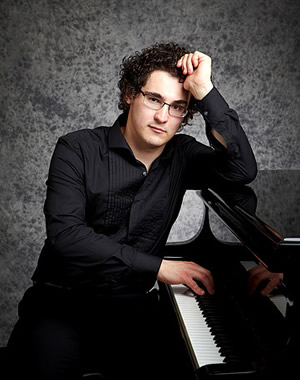To borrow a line from the late Walter Legge, the opening recital of this year’s Paderewski Festival – the third annual – included the best performance of Mussorgsky’s Pictures at an Exhibition I have ever heard in the concert hall. It was the closing selection on a recital that also ranks from start to finish among the very best I’ve heard anywhere in the world. Yes, it was that good. And it took place in Smedes Parlor, the historic concert room on the campus of Saint Mary’s School, before a relatively small audience of comparably awe-struck music lovers. With this remarkable program, young Artem Yasynskyy, a native of Donetsk, Ukraine, who has already won considerable recognition, made a spectacular NC debut with some very unusual repertoire – all played from memory – and a few concert staples that left no doubt in anyone’s mind that this is a supreme player, technically and artistically. Indeed, he’s a master. And he’s all of 28.
Following welcoming remarks by Dr. Mark Fountain, president, and Adam Wibrowski, the festival’s artistic director, the program began with two Scarlatti sonatas, delivered with the utmost clarity and precision. These brief pieces, by a composer often considered part of the baroque era but who in fact pointed toward the early classical period, allowed Yasynskyy to introduce himself and his art on a relatively small scale. In seconds, we were drawn into his artistic realm, and the response from the crowd was immediate and sustained.
He then turned to four Character Sketches by Josef Hofmann, best known in America as a concert pianist and as a director of the Curtis Institute of Music in Philadelphia. Wibrowski spent a considerable amount of time introducing him because he has been largely forgotten by music lovers today, but it may be worth noting that Gregor Benko and Ward Marston have devoted years to finding and preserving Hofmann’s many recordings, a project that is expected to reach culmination in 2017. (Click here for details.)
Hofmann’s own music is little known, so the inclusion here of these four short pieces was noteworthy, and in addition the music has much to recommend it. (The score is here.) The music seems at first hearing a mix of impressionism with Rachmaninoff, here light and fluttering, there more dramatic and forceful, sometimes straightforward melodically and at other times complex. Yasynskyy infused these works with light and shade, displaying keen interpretive sensitivity and insight that reflected close study – so it should come as no surprise that he has recorded a whole CD of these works, a recording that includes a piano sonata, a theme with variations and a fugue, and other, shorter items (available on Grand Piano GP675, an imprint of HNH).
There followed another extreme rarity, this one the Holiday Diary, Op. 5 (1934), by the young Benjamin Britten. This is a short suite of four numbers, dedicated to his piano teacher, that evoke water in ways that seem to prefigure the composer’s much later maritime obsessions. These too received commanding renditions by the visiting artist, performances that brought the music to vivid life.
Closing the first half was a truly magnificent reading of Book I of Brahms’s Variations on a Theme by Paganini. (The theme is from Paganini’s Caprice No. 24.) This netted us the theme and 14 variations. The rest of the work – that is to say, Book II – will be heard in the concert scheduled for Nov. 6 at the NC Museum of History, for details of which, see below.
Three short pieces by the festival’s honoree, Ignacy Jan Paderewski, launched the second half of the program. There seemed a certain kinship between these and the Hofmann played earlier although these Chants du voyager (Travelers’ Tales) contain a good deal more folk influence and stronger hints of the sort of accents and themes that make one think the music is better known than it is. As elsewhere during this concert, the performer inhabited this music totally and produced in the process performances at once engaging and fascinating.
And then there came the Pictures, by Mussorgsky. The piano score depicts a visit to a gallery displaying works by Viktor Hartmann, a friend of the composer who had recently died. (Some of the images may be seen here.) It was a slight miscalculation to omit the titles of the work’s sections from the program; there’s a link to them here. But the absence seemed to concern almost no one, for this performance engaged and captivated those in attendance from the very first measures. What made it so special? Well, again, this artist crawled inside the music’s skin. His articulation, phrasing, clarity, precision, and dynamics consistently showed his mastery. He never lost sight of the long line, structuring the score as a unified whole as opposed to a series of detached movements. Again he brought this relatively old music to vibrant life, as if we were hearing it for the first time. That’s ridiculous, of course, for such a well-known piece, a piece perhaps better known in its various orchestral guises than in its original piano incarnation. This is the magic and mystery of art. And Yasynskyy is an artist with a capital “A.”
So this visitor has set an exceptionally high bar…, but there are three more recitals (and a film) on this year’s festival, which continues on Nov. 6 with Jean Dubé, of France, in recital at the NC Museum of History. For more information on this and the remaining events, please see the side bar. And for answers to all your Paderewski questions, see the presenter’s website.
Note: There were two encores: a lovely mazurka by Hofmann and Horowitz’s transcription of themes from Bizet’s Carmen.











